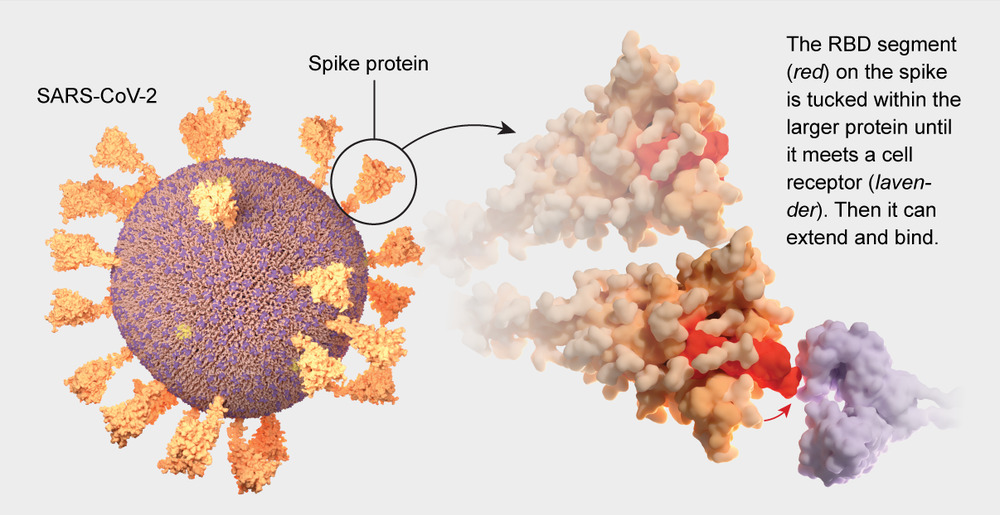buffy said:
I found this stuff very interesting.
https://www.scientificamerican.com/article/artificial-proteins-never-seen-in-the-natural-world-are-becoming-new-covid-vaccines-and-medicines/
(I think you can have some “free” articles each month with SciAm, so you should be able to read that one)
Very interesting, thanks.
> Each spike ends in a cluster of amino acids—a section of the protein known as the receptor-binding domain, or RBD—whose alignment and atomic charges pair perfectly with a protein on the surface of human cells.
Good.
> the RBD is periodically hidden by other parts of the spike protein, shielding the domain from antibodies looking to bind to it. This blunts the immune response.
If the RBD is hidden then the virus wouldn’t be infectious, would it? The more it’s hidden, the less infectious the virus is. OIC, image below, allows some infectiousness even when the RBT is completely hidden.

> In addition, a free-floating spike protein does not resemble a natural virus and does not always trigger a strong reaction unless a large dose of vaccine is used. That big dose increases costs and can trigger strong side effects. Just delivering natural or stabilized proteins is not sufficient
Fair enough, but it does allow a vaccine to be produced a very short time after virus sequencing, to bridge the time gap before better vaccines become available.
> the RBD segment on its own would be too small and unfamiliar to get the immune system’s attention.
Ah, now that I didn’t know.
> In 2019 a group in the IPD led by biochemist Neil King had designed two tiny proteins with complementary interfaces that, when mixed together in solution, would snap together and self-assemble into nanoparticles. These balls were about the size of a virus and were completely customizable through a simple change to their genetic code. When the scientists festooned the particles with 20 protein spikes from the respiratory syncytial virus, the second-leading cause of infant mortality worldwide, they triggered an impressive immune response
Like :-))
> the protein-based nanoparticle would be cheap and fast to produce compared with vaccines that use killed or weakened virus.
Like. Cheap and fast to produce in bulk , yes. Killed virus is the cheapest and fastest in small quantities, for emergency purposes, such as for the family of case 0.
> a nanoparticle sphere displaying 60 copies of the RBD. The scientists also tried something radical: Instead of fusing the RBDs directly to the surface of the nanoparticle, they tethered them with short strings of amino acids, like kites. Giving the RBDs a little bit of play could allow the immune system to get a better look.
:-))
> in mice that got the nanoparticle vaccine, the pseudovirus was completely outmatched.
:-))

> Natural antibodies are also relatively big proteins that are not always able to get their business end snug against a virus’s RBD. Enter the “mini binders,”. These are small synthetic proteins that can be designed amino acid by amino acid to fit precisely against a virus’s RBD. With no extraneous bits, they bind more tightly. And they are small and lightweight enough to be administered through a nasal spray. Create a medication rather than a vaccine: that could be used at the first sign of infection—or beforehand as daily prevention—to flood the nose with a mist of mini binders that would coat the RBDs of virus particles before they could attach to anything.
:-)) Beats honey, lemon and eucalyptus throat lozenges as a first treatment.
> tailored mini binders. The best designs were made of three helixes connected like sausage links by short strings of amino acids. Each mini binder was about 60 amino acids long in total—less than a tenth the size of an antibody and a twentieth the size of a coronavirus spike.
> DNA can be printed for pennies on devices that resemble inkjet printers. Cao printed DNA strands with the sequence for his mini binder and inserted them into yeast, which, like programmable livestock, pumped out those tiny proteins along with their normal ones. He then harvested the proteins and tested them. The top mini binder bound the virus six times more effectively than the best antibodies known—better than any molecule on the planet, in fact, forming dozens of strong bonds with the RBD.
:-))
The biggest risk I can see is that the mini-binders may bind not just to virus RBT but to natural RBTs in the human body that are essential for life. The next biggest risk is that antibodies may attack the mini-binders, neutralising them.
Looks like great work to me. It needs to be fast-tracked, by that I mean available for sale in three months not twelve.